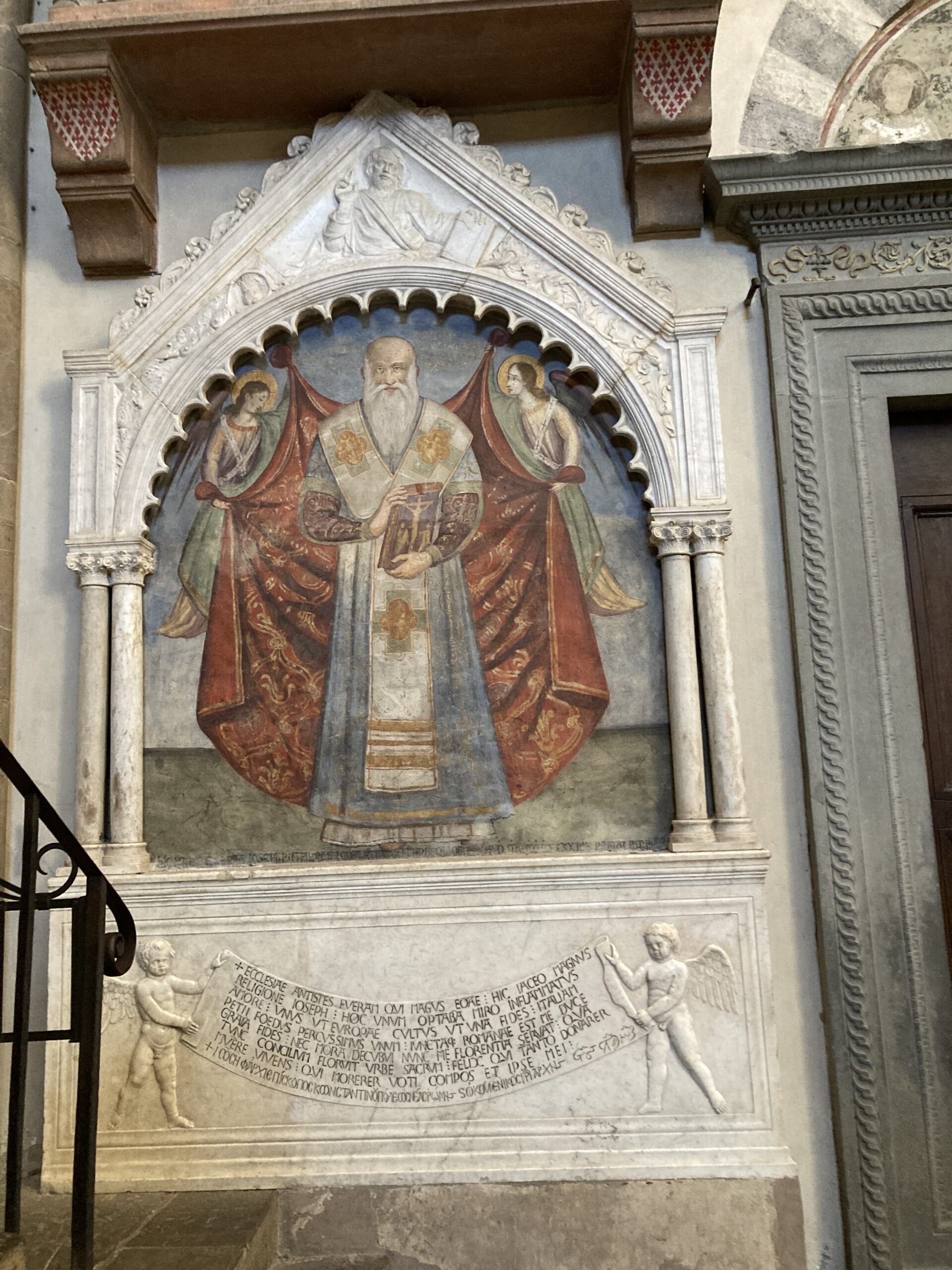
Painted Portrait of Patriarch Joseph II of Constantinople, 1590-92, Santa Maria Novella, Florence, Italy
Photo credit: Amalia Spiliakou, April 2025
Patriarch Joseph II of Constantinople was a pivotal figure in the history of the Eastern Orthodox Church, most notably for his participation in the Council of Ferrara-Florence (1438–1439), a major attempt to reconcile the long-standing schism between the Eastern and Western Christian churches. As the spiritual leader of the Eastern delegation, he played a crucial role in the theological dialogues aimed at achieving ecclesiastical unity. Though the union was short-lived, his involvement marked a significant moment of engagement between East and West. Patriarch Joseph II passed away during the council in Florence in 1439, and fittingly, his tomb remains in the Dominican church of Santa Maria Novella, an enduring symbol of his commitment to bridging divided faiths.
Born around 1360, likely in Constantinople, he was of noble origin and possibly related, on his father’s side, to the Bulgarian royal family. Before rising to the patriarchate, Joseph became a monk on Mount Athos and later served as the Metropolitan of Ephesus. In 1416, he was elected Ecumenical Patriarch of Constantinople, leading the Orthodox Church during a time of both spiritual and geopolitical crisis as the Byzantine Empire faced increasing pressure from the advancing Ottoman Turks.
A staunch supporter of church unity, Joseph II was a central participant in the Council of Ferrara-Florence (1438–1445), convened to heal the East-West Schism between the Orthodox and Roman Catholic Churches. His delegation sought Western military aid in exchange for theological concessions, a strategy driven by the empire’s desperate political situation. Despite his ill health, Joseph played a vital role in the negotiations, advocating dialogue and reconciliation. He died in Florence on June 10, 1439, before the council concluded, and was buried with honor in the church of Santa Maria Novella. His tomb remains there today, a rare and poignant symbol of his commitment to Christian unity and the enduring legacy of his leadership in a time of upheaval.
Although no literary or theological works by Patriarch Joseph II of Constantinople are known to have survived, his contemporaries spoke highly of his intellect and character. Ambrogio Traversari, in a letter dated February 20, 1438, praised him as venerable, so refined, with common sense, experience in life, and added, in my judgment, I think that today one could not find his like in all of Greece [Byzantium], noting that their conversation and the patriarch’s demeanor arouses respect. In Personalities of the Council of Florence, and Other Essays, Joseph Gill echoes this view, portraying Joseph II as a spiritually and intellectually vibrant leader despite his old age and deteriorating health. Nearly eight years old and suffering from heart disease, the Patriarch nonetheless demonstrated keen insight, prudent judgment, and steadfast dedication to the cause of church union until his death in Florence, shortly before the council concluded.
The Tomb of Patriarch Joseph II of Constantinople in the church of Santa Maria Novella, Florence, is a striking monument that reflects both historical reverence and artistic devotion. Created by a Florentine sculptor around 1440, the tomb commemorates the Eastern Patriarch who died in Florence during the Council of Florence, a major attempt at reunifying the Eastern and Western Churches. A later painted portrait (1590–92) complements the sculptural work, offering a vivid image of the patriarch. Ambrogio Traversari, a key figure in the council and admirer of Joseph II, described him with deep respect… The father is old, and, like his age, his grey hair, long beard and face make him a venerable figure to all who see him. This description is poignantly echoed in both the tomb and the painting, which together convey the spiritual dignity and serene wisdom of a man who symbolized unity and holiness at a crucial moment in church history. https://www.scribd.com/document/688389117/GILL-J-Personalities-of-the-Council-of-Florence-Joseph-II
For a Student Activity, please… Check HERE!